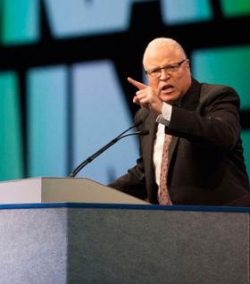Has AFSCME Found the Cure to Harris v. Quinn?
X post in Labor
 http://inthesetimes.com/working/entry/16963/has_afscme_found_the_cure_to_harris
http://inthesetimes.com/working/entry/16963/has_afscme_found_the_cure_to_harris
WEDNESDAY, JUL 16, 2014, 6:09 PM
BY DAVID MOBERG

'Today, we are 92,155 members stronger, with new members from EMTs to home care workers, and we will continue our fight for the middle class and the future of this country,' AFSCME president Lee Saunders said at the 41st International convention in Chicago July 14. (Courtesy of AFSCME)
The just-released results of a six-month initiative by the American Federation of State, County and Municipal Employees (AFSCME) suggest that the dark cloud cast over public sector unionism by a recent Supreme Court decision may not be so threatening after all.
Many analysts saw the court’s ruling last month in Harris v. Quinn as a profound blow to public sector unions such as AFSCME. In a case involving workers who receive state funds to provide home care for people with disabilities, the court found that the Service Employees International Union (SEIU) could not collect “fair share” payments from workers who declined to join the union. A significant share of public workers—especially in home care work, where workers are spread out over various workplaces—have been required to pay these reduced dues to compensate unions such as AFSCME and for their bargaining and representation work. Unions fear that in future rulings, the Supreme Court will eventually nix fair share fees for all public workers, or even all workers.
But a recent experiment by AFSCME may point the way to how unions can reduce the harmful effects of Harris.
In January, leaders of the 1.6-million-member union set a target of becoming “50,000 stronger” by the start of the convention through “internal organizing”—that is, recruiting workers who were paying “fair share” dues or nothing at all to become full-fledged, dues-paying members. What was notable about the union’s approach was that, rather than bring in professional organizers, AFSCME used volunteer member organizers (VMOs). These volunteers approached their co-workers, or those at similar workplaces, to make the case for joining the union. AFSCME, like many other unions, has used VMOs before, but never on such a large scale.
FULL story at link.

